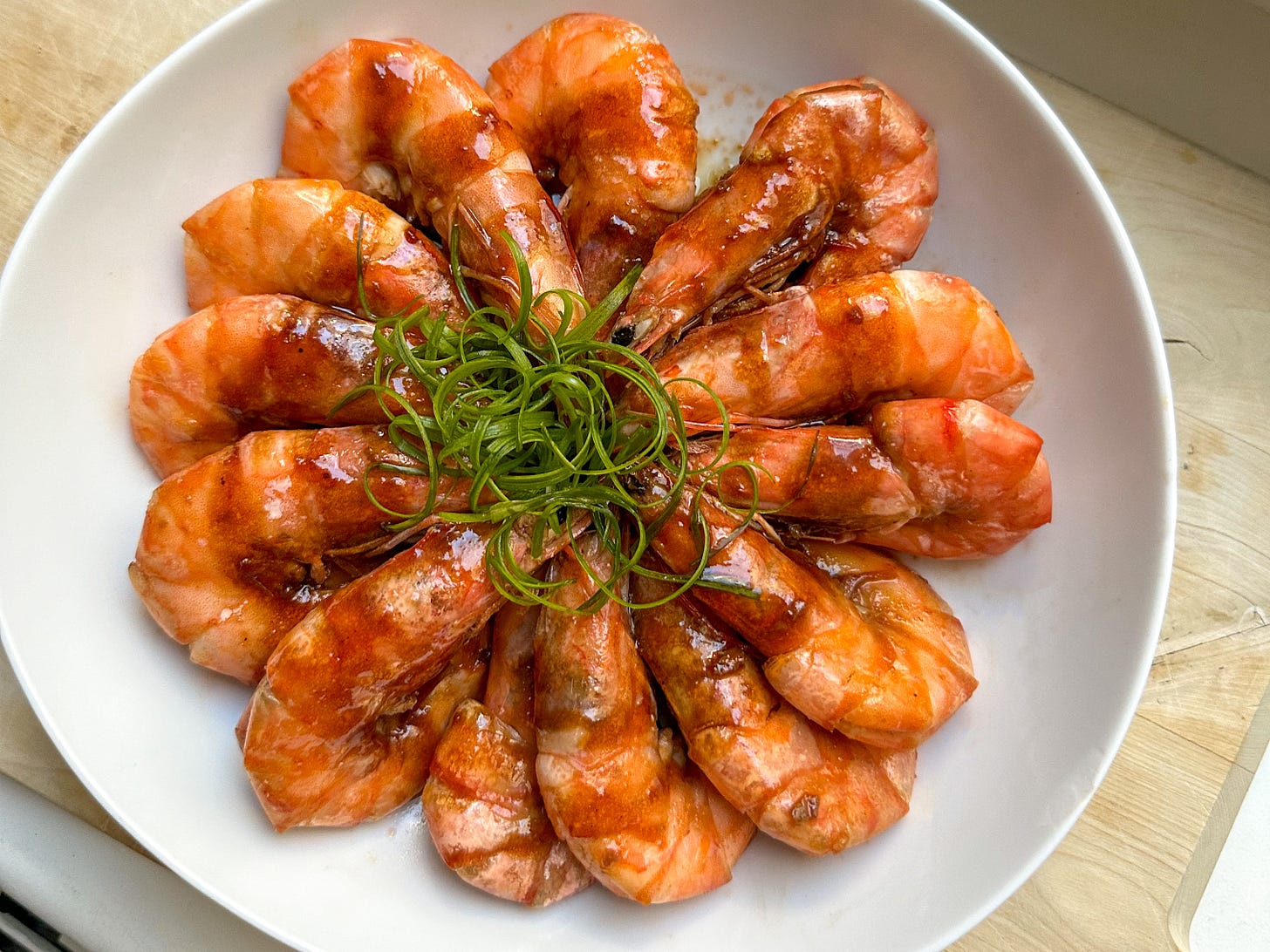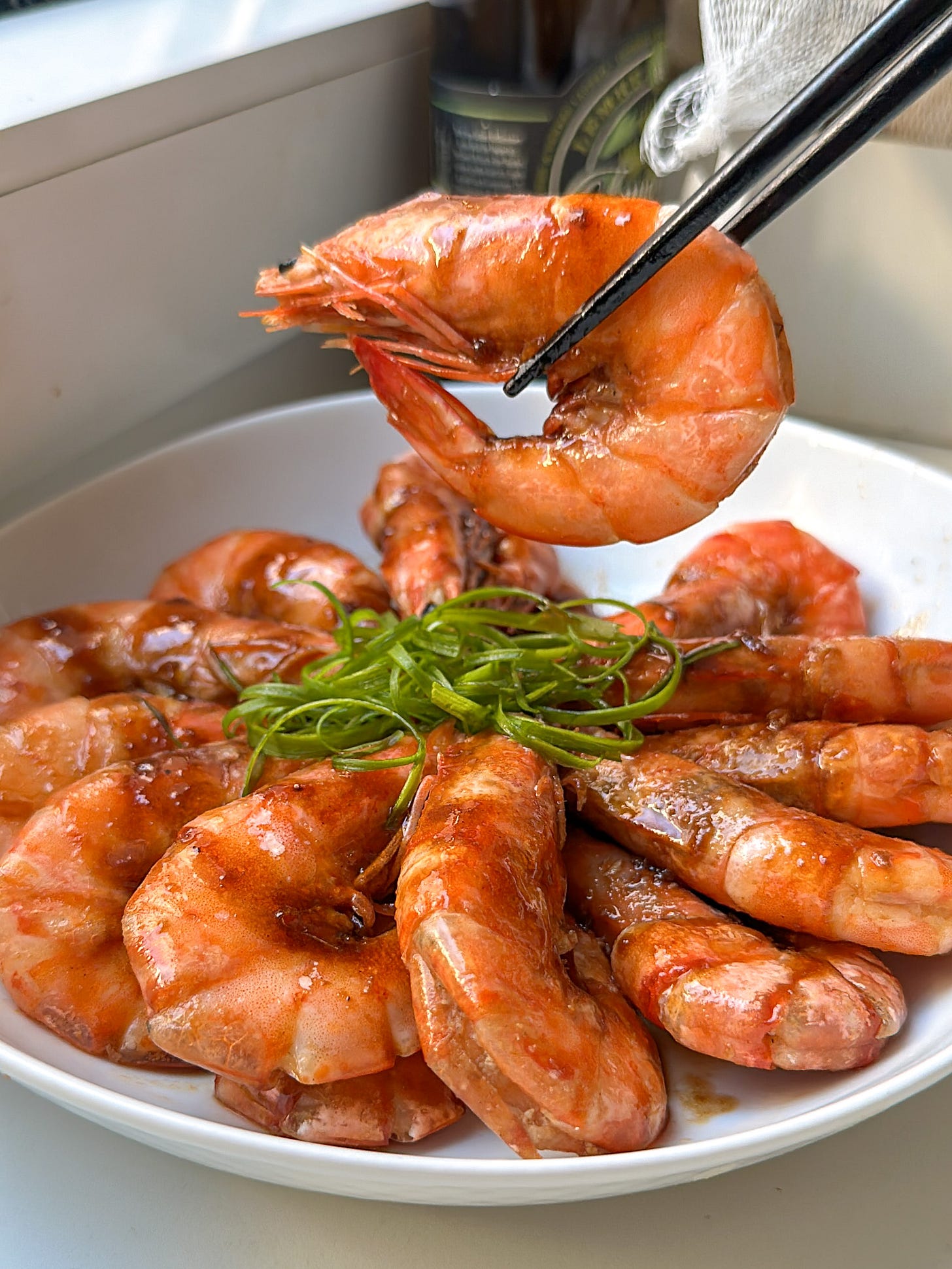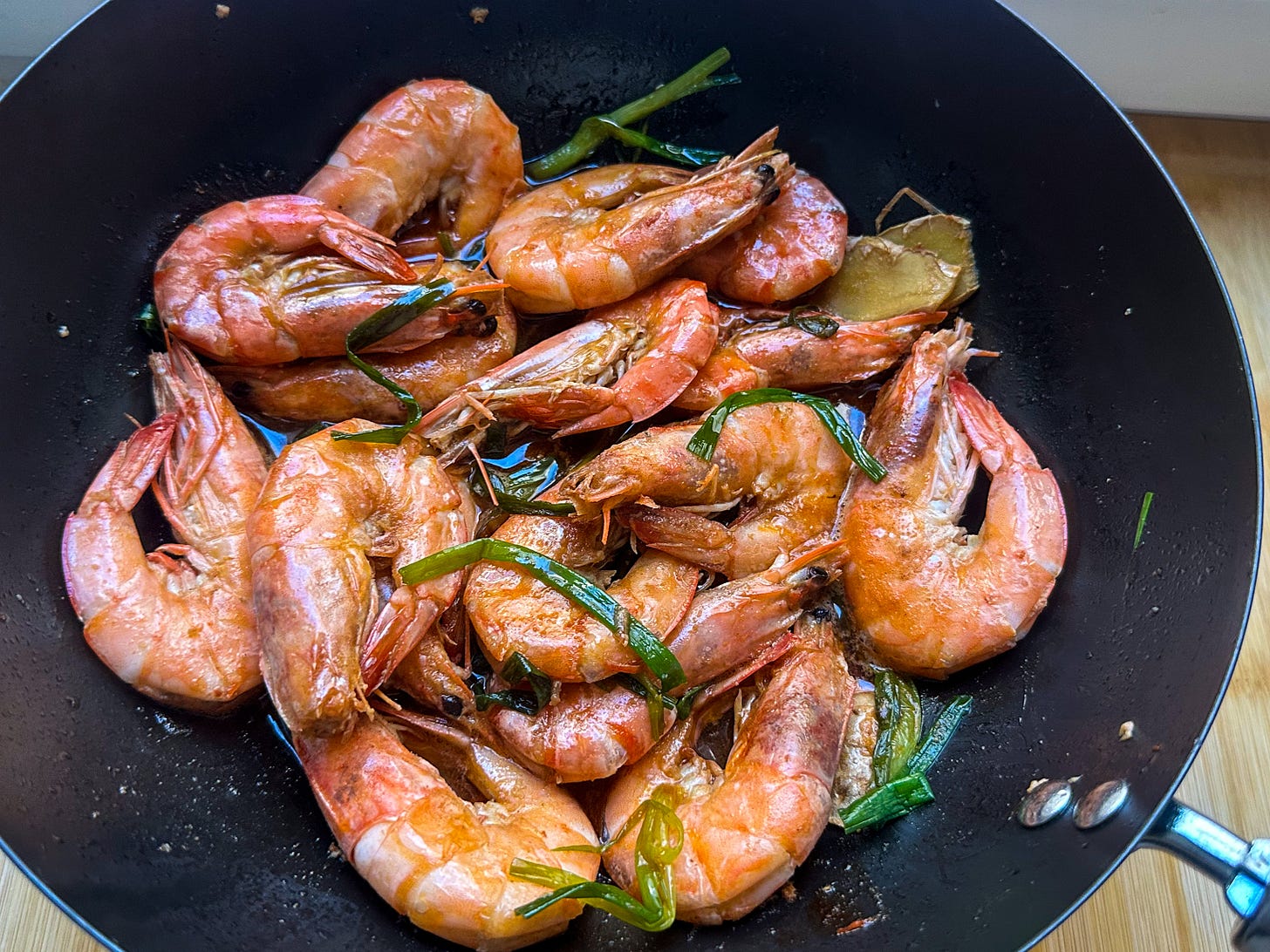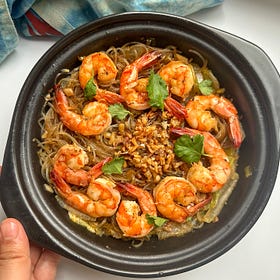Chinese Braised Large Shrimp (Youmen Daxia)
The best effort-to-impress dish for your CNY dinner party
During the week-long celebration of Chinese New Year, my family balanced home feasts centered on cured meats (coming soon!) with occasional restaurant banquets. These meals often featured indulgent seafood dishes, like crabs and shrimp—ingredients rarely prepared at home. Shrimp, in particular, was served either deep-fried with a salt and pepper seasoning, blanched with a dipping sauce (a style called baizhuo 白灼), or braised in a rich soy-based sauce. One year, a big plate of fried shrimp appeared at our table. While the adults were busy chatting, we kids stealthily ate all the shrimp meat, leaving behind a pile of empty heads. When the adults finally noticed, they were convinced the kitchen had scammed us and even called the waitress to complain—only to be embarrassed when we sheepishly confessed to our mischief.
Growing up inland in Sichuan, where freshwater fish from the Yangtze River and local lakes were more accessible, seafood was luxury. Before the arrival of fancy Wagyu or Michelin-starred restaurants, Chengdu’s most sought-after dining experiences were at seafood establishments. It wasn’t until I was 14, during a summer camp trip to Qingdao, on China’s eastern coast in the Shandong province, that I saw the ocean for the first time. In a fishing village, we went jellyfish hunting on a boat and ate meals full of seafood, and I marveled at how seafood was just part of their daily meals.
The Dish: A Coastal Classic
Youmen Daxia (油焖大虾) is an iconic dish from Shandong cuisine (Lucai, 鲁菜), traditionally made with Chinese white shrimp from Bohai Bay in the spring. (Some argue this dish originated in Hubei.) Along China’s coast, variations abound. In Shanghai, a dish called youbaoxia (油爆虾) deep-fries smaller freshwater shrimp, while Cantonese regions favor a quicker sautéed version called chiyouhuang jianxia (豉油皇煎虾). Essentially, the shrimp are wok-fried and braised with rich broth made with shaoxing wine, soy sauce and sugar.
For me, Youmen Daxia is both nostalgic and practical. It’s a low-effort showstopper: just a handful of ingredients and less than 30 minutes to prepare (if your shrimp are already defrosted!). With a little attention to presentation, it can easily serve as the centerpiece for your Lunar New Year dinner—or any occasion that calls for something a little fancy. The perfect oil-braised shrimp should have a bright, glossy, reddish finish and a balance of umami, savory, and sweet flavors.
Recipe for Chinese Braised Large Shrimp
Serves: 2 as standalone dish, more if you’re making more dishes
Ingredients
450g (1 pound) jumbo shrimp
15 g ginger (4 thick slices)
3 scallions (or 1 large shallot)
3 tbsp vegetable oil
3 tbsp Shaoxing wine
1 tbsp sugar
1/2 tsp salt
1 tbsp light soy sauce
1 tsp dark soy sauce
1/4 tsp white pepper
1 tsp sesame oil (optional)
Instructions
Defrost, wash and dry the shrimp. Trim the sharp beaks and legs. Make a shallow cut along the back and devein them. Pat dry with a paper towel.
Cut the white and light green parts into 5 cm (2 inches) pieces. Slice the green tops into thin threads, soak them in cold water, and reserve them for garnishing.
Heat 3 tbsp oil in a wok over medium heat. Add the shrimp, pressing the heads with a spatula to release flavor. Fry for 1-2 minutes on each side until the shells turn bright red. Add ginger and scallion pieces and stir-fry briefly until fragrant.
Pour Shaoxing wine along the edge of the wok, then add sugar, salt, and light and dark soy sauces. Stir to combine, then cover and let simmer for 5 minutes.
Remove the shrimp and arrange it on a serving plate. Discard the ginger and scallions. Reduce the sauce in the wok over high heat until glossy and thick. Turn off the heat, add sesame oil if using, then drizzle over the shrimp. Garnish with scallion greens.
Tips for Making Braised Shrimp
Choosing Shrimp
Shrimp sizes are labeled by the number of pieces per pound. I’m using a size 20/30 for this dish. For an impressive dish, opt for large, jumbo or even colossal shrimp. Fresh, live shrimp are ideal, but in cities like Berlin where seafood options can be limited, high-quality frozen shrimp work well. I recommend using Ecuadorian white shrimp or South Asian black tiger shrimp. If your shrimp are smaller or come without shells or heads, reduce the cooking time accordingly.'
Prepping Shrimp
For braised dishes like this, shrimp are traditionally cooked with their shells and heads intact, as they hold the most flavor. Pressing the heads during cooking releases even more richness. Shell-on shrimp may require a little effort to peel at the table, but for many Chinese diners, that’s part of the joy—and even a gesture of love when done for others.
If using whole shrimps with heads on: with a pair of kitchen shears, snip off the sharp beak part, antenna legs, and antennae. Use a knife (or shears) make a shallow cut along the back, and use a toothpick to pull out the vein, discard. This also helps the shrimp absorb more flavor. (see the clip below of how I prepared the shrimp)
The Oil-Braising Technique
The technique of oil-braising (you men, 油焖) involves shallow or deep-frying ingredients before briefly simmering them in a small amount of broth. Generous oil prevents the shrimp from over-drying while extracting flavors from the shells and heads. You can even use lard for extra richness.
For the braising part, many recipes call for adding water, but I’ve found that the shrimp release enough liquid on their own. Instead, I rely on Shaoxing wine to enhance the aroma and use a lighter touch with soy sauce to preserve the shrimp’s natural sweetness and umami. n the short braise, the shrimp will release more flavor while also absorbing flavors from the soy sauce mixture—a nice exchange.
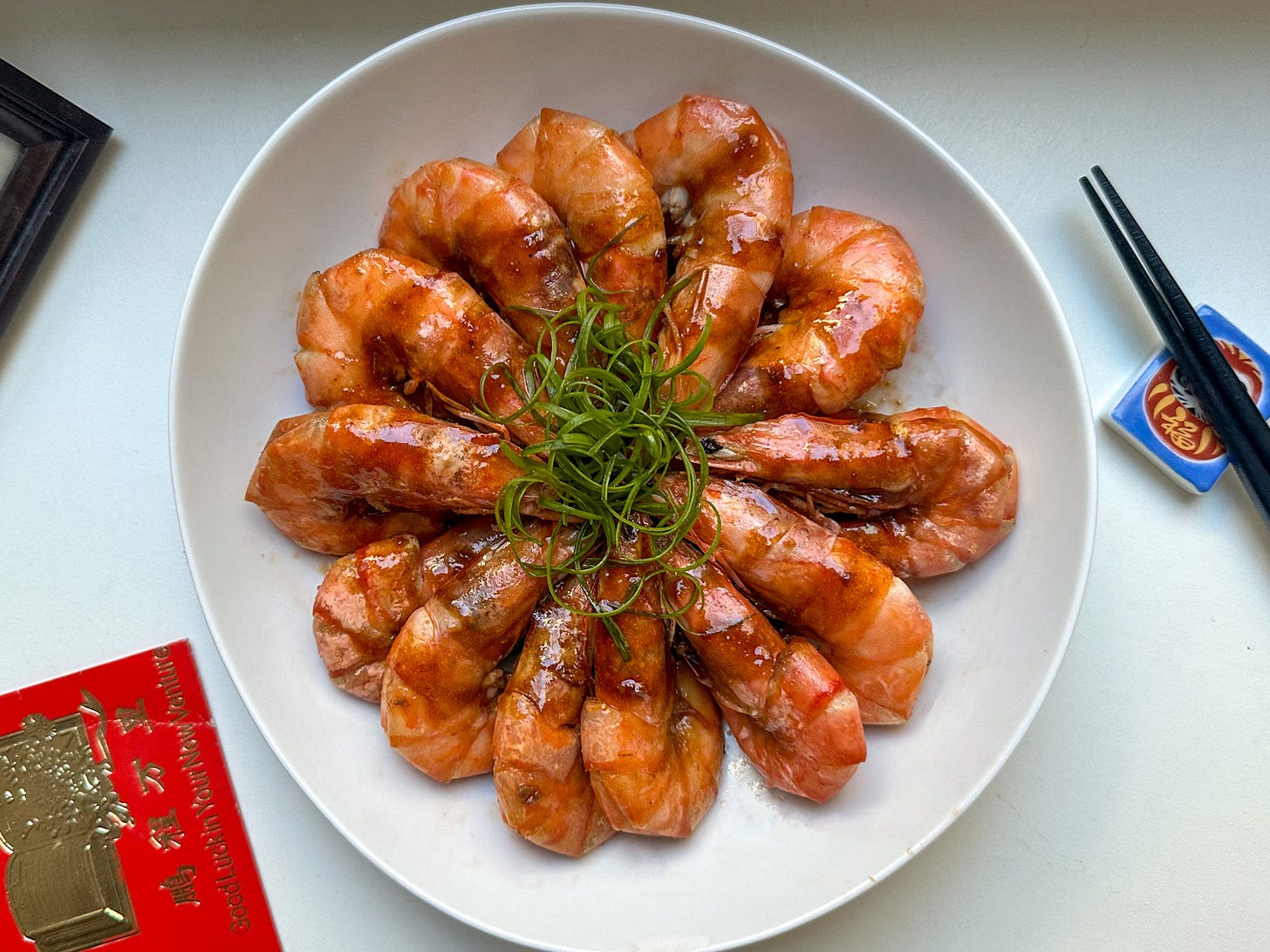
Another shrimp dish perfect for dinner party:
Garlicky Shrimp with Vermicelli and Cabbage
Hey there! I’m currently visiting family back in Sichuan, so this newsletter is a bit delayed (blame the travel chaos). But more about what I eat in China is headed your way!




